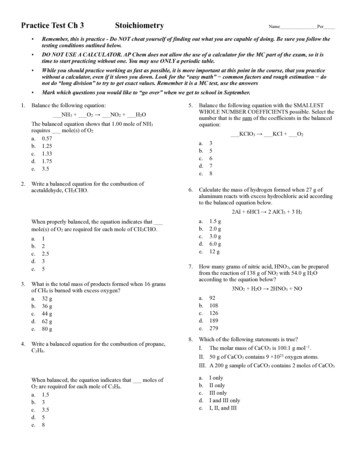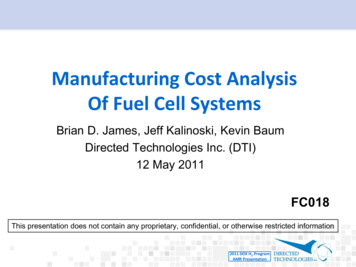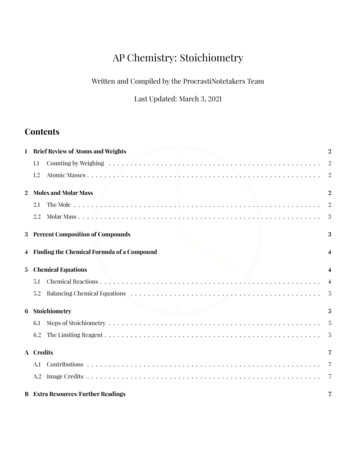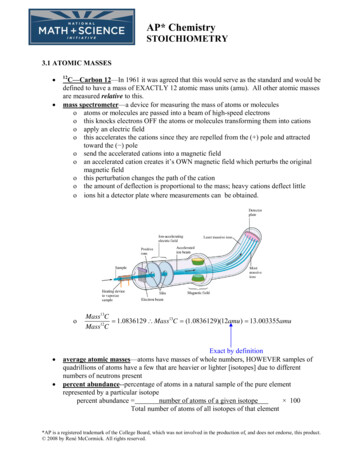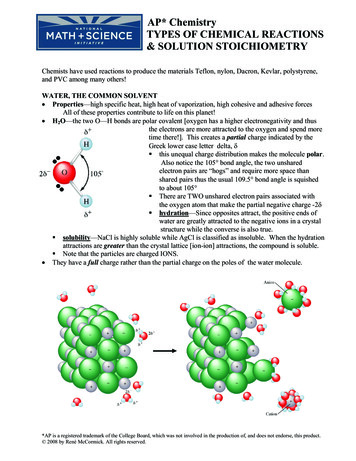
Transcription
Chapter 3: StoichiometryKey Skills: Balance chemical equations Predict the products of simple combination, decomposition, and combustion reactions. Calculate formula weights Convert grams to moles and moles to grams using molar masses. Convert number of molecules to moles and moles to number of molecules usingAvogadro’s number Calculate the empirical and molecular formulas of a compound from percentagecomposition and molecular weight. Identify limiting reactants and calculate amounts, in grams or moles, or reactantsconsumed and products formed for a reaction. Calculate the percent yield of a reaction.Stoichiometry is the study of thequantitative relationships in substancesand their reactions–Chemical equations–The mole and molar mass–Chemical formulas–Mass relationships in equations–Limiting reactant1
Definitions Reactants are the substances consumedProducts are the substances formedCoefficients are numbers before theformula of a substance in an equationA balanced equation has the samenumber of atoms of each element on bothsides of the equationChemical Equations A chemical equation is a shorthand notation todescribe a chemical reaction– Just like a chemical formula, a chemical equationexpresses quantitative relations Subscripts tell the number of atoms of each element in amolecule Coefficients tell the number of molecules2
Coefficients vs. SubscriptsHydrogen and oxygen can make water or hydrogen peroxide2 H2(g) O2(g) 2 H2O(l)H2(g) O2(g) H2O2(l)3
Anatomy of a Chemical EquationReactants appear on theleft side of the equation.Products appear on theright side of the equation.The states of the reactants and products are written inparentheses to the right of each element symbol or formula.Writing Balanced Equations Write the correct formula for eachsubstanceH2 Cl2 HClAdd coefficients so the number of atomsof each element are the same on bothsides of the equationH2 Cl2 2HCl4
Balancing Chemical Equations Assume one molecule of the most complicatedsubstanceC5H12 O2 CO2 H2OAdjust the coefficient of CO2 to balance CC5H12 O2 5CO2 H2OAdjust the coefficient of H2O to balance HC5H12 O2 5CO2 6H2OAdjust the coefficient of O2 to balance OC5H12 8O2 5CO2 6H2OCheck the balance by counting the number ofatoms of each element.Balancing Equations Sometimes fractional coefficients areobtainedC5H10C5H10C5H10C5H10 O2 O2 O2 (15/2)CO2 H2O5 CO2 H2O5 CO2 5 H2OO2 5 CO2 5 H2OMultiply all coefficients by thedenominator2 C5H10 15 O2 10 CO2 10 H2O5
CombinationDecompositionOne substance breaks down into two ormore substances2 NaN3 (s) 2 Na (s) 3 N2 (g)CaCO3 (s) CaO (s) CO2 (g)2 KClO3 (s) 2 KCl (s) O2 (g)6
CombustionIs the process of burning, thecombination of an organic substancewith oxygen to produce a flame. When an organic compound burns in oxygen,the carbon reacts with oxygen to form CO2,and the hydrogen forms water, H2O.Balance the following combustion reactions:C3H8 O2 CO2 H2O(C2H5)2O O2 CO2 H2OFormula Weight (FW) Sum of the atomic weights for theatoms in a chemical formula The formula weight of calciumchloride, CaCl2, would beCa: 1(40.08 amu) Cl: 2(35.45 amu)110.98 amu Formula weights are generallyreported for ionic compounds7
Molecular Weight (MW) Sum of the atomic weights of theatoms in a molecule For the molecule ethane, C2H6, themolecular weight would beC: 2(12.01 amu) H: 6(1.008 amu)30.07 amuPercent CompositionOne can find the percentage of themass of a compound that comesfrom each of the elements in thecompound by using this equation:% element (number of atoms)(atomic weight)(FW of the compound)x 100%8
Percent CompositionSo the percentage by mass of carbonin ethane (C2H6) is %C (2)(12.01 amu)(30.068 amu)x 10024.02 amux 10030.068 amu 79.89%The Mole One mole is the amount of substance that contains asmany entities as the number of atoms in exactly 12grams of the 12C isotope of carbon.Avogadro’s number is the experimentallydetermined number of atoms in 12 g of isotopicallypure 12C, and is equal to 6.022 x 1023One mole of anything contains 6.022 x 1023 entities 1111molmolmolmolH 6.022 x 1023 atoms of HH2 6.022 x 1023 molecules of H2CH4 6.022 x 1023 molecules of CH4CaCl2 6.022 x 1023 formula units of CaCl29
Moles to Number of EntitiesMoles ofsubstanceAvogadro’snumberNumber ofatoms ormoleculesExample Calculations How many Na atoms are present in0.35 mol of Na?How many moles of C2H6 are presentin 3.00 x 1021 molecules of C2H6?10
Molar MassThe molar mass (M) of anyatom, molecule or compoundis the mass (in grams) of onemole of that substance.The molar mass in grams isnumerically equal to the atomicmass or molecular massexpressed in u (or amu).Atomic ScaleLab ScaleSubstanceNameMassMolar MassArC2 H 6atomic massmolecularmassformula mass39.95 u30.07 u39.95 g/mol30.07 g/mol41.99 u41.99 g/molNaFWhat mass of compound must beweighed out, to have a 0.0223 molsample of H2C2O4 (M 90.04 g/mol)?Oxalic acid11
Interconverting masses andnumber of formula unitsExample CalculationWhat is the mass of 0.25 moles of CH4? 16.0 g CH 4 4.0 g CH 40.25 mol CH 4 1 mol CH 4 Empirical formulaExample 1: What is the empirical formula of a compound thatcontains 0.799 g C and 0.201 g H in a 1.000 g sample?Example 2: What is the empirical formula of a chromium oxidethat is 68.4% Cr by mass?12
Combustion Analysis Compounds containing C, H and O are routinely analyzed throughcombustion in a chamber like this– C is determined from the mass of CO2 produced– H is determined from the mass of H2O produced– O is determined by difference after the C and H have beendeterminedFinding C and H content A weighed sample of compound is burned, and themasses of H2O and CO2 formed is measured.13
Calculating Empirical FormulasExample: The compound para-aminobenzoic acid (youmay have seen it listed as PABA on your bottle ofsunscreen) is composed of carbon (61.31%), hydrogen(5.14%), nitrogen (10.21%), and oxygen (23.33%). Findthe empirical formula of PABA.Assuming 100.00 g of para-aminobenzoic acid,C:H:N:O:1 mol12.01 g1 mol5.14 g x1.01 g1 mol10.21 g x14.01 g1 mol23.33 g x16.00 g61.31 g x 5.105 mol C 5.09 mol H 0.7288 mol N 1.456 mol OCalculating Empirical FormulasCalculate the mole ratio by dividing by the smallest numberof moles:C:5.105 mol0.7288 mol 7.005 7H:5.09 mol0.7288 mol 6.984 7N:0.7288 mol0.7288 mol 1.000O:1.458 mol0.7288 mol 2.001 2C7H7NO214
Example CalculationA compound contains only C, H, and O. A 0.1000 gsample burns completely in oxygen to form 0.0930 gwater and 0.2271 g CO2. Calculate the mass of eachelement in this sample. What is the empirical formula ofthe compound?ComparisonFormula to mass percentMass percent to formulaSubscripts informulaAtomic massesMasses ofelements andcompoundMass of elementx 100%Mass of compoundPercentcompositionComposition(mass or mass %)Molar massesof elementsMoles ofeach elementDivide bysmallest numberEmpiricalformula15
Mole Relationships in EquationsGuidelines for Reaction Stoichiometry Write the balanced equation.Calculate the number of moles of the species for which themass is given.Use the coefficients in the equation to convert the moles ofthe given substance into moles of the substance desired.Calculate the mass of the desired species.16
Example CalculationGiven the reaction4FeS2 11 O2 2Fe2O3 8SO2What mass of SO2 is produced from reaction of3.8 g of FeS2 and excess O2?Example CalculationWhat mass of SO3 forms from the reactionof 4.1 g of SO2 with an excess of O2?17
Reaction YieldsActual yield is found by measuringthe quantity of product formed inthe experiment.Theoretical yield is calculated fromreaction stoichiometry.% yield Actual yield 100%Theoretical yieldExample: Calculating Percent YieldA 10.0 g-sample of potassium bromide is treatedwith perchloric acid solution. The reactionmixture is cooled and solid KClO4 is removed byfiltering, then it is dried and weighed.KBr (aq) HClO4 (aq) KClO4 (s) HBr (aq)The product weighed 8.8 g. What was thepercent yield?18
Limiting ReactantLimiting reactant : the reactant that iscompletely consumed in a reaction. When it isused up, the reaction stops, thus limiting thequantities of products formed.Excess reactant : the other reactants present,not completely consumed2H2(g) O2(g) 2H2O(g)O2H219
2H2(g) O2(g) 2H2O(g)5[2H2(g) O2(g) 2H2O(g)]10H2(g) 5O2(g) 10H2O(g)2H2(g) O2(g) 2H2O(g)5[2H2(g) O2(g) 2H2O(g)]10H2(g) 5O2(g) 10H2O(g)20
Strategy for Limiting ReactantMass of A(reactant)Mass of B(reactant)Molar mass of AMolar mass of BMoles of AMoles of BCoefficients in the equationMoles ofProductChoosesmalleramountMoles ofProductMolar mass of productMass ofproduct21
Example CalculationCalculate the theoretical yield (g) when 7.0 gof N2 reacts with 2.0 g of H2, forming NH3.Example CalculationOne reaction step in the conversion of ammonia to nitric acidinvolves converting NH3 to NO by the following reaction:4 NH3(g) 5 O2(g) 4 NO(g) 6 H2O(g)If 1.50 g of NH3 reacts with 2.75 g O2, then:1. Which is the limiting reactant?2. How many grams of NO and H2O form?3. How many grams of the excess reactant remain after thelimiting reactant is completely consumed?4. Is the law of conservation of mass obeyed?22
,v wkh surfhvv ri exuqlqj wkh frpelqdwlrq ri dq rujdqlf vxevwdqfh zlwk r[\jhq wr surgxfh d iodph :khq dq rujdqlf frpsrxqg exuqv lq r[\jhq wkh fduerq uhdfwv zlwk r[\jhq wr irup &2







